-
Notifications
You must be signed in to change notification settings - Fork 2
2000 2001 Meldal
In my hand I hold a small piece of equipment - say the size of a quarter or so, and as light.[^26] When I slip this sliver of a thing into my camera (or into my laptop computer), I gain one gigabyte of storage space. The little microdrive is a 4500 RPM hard disk. Give me a couple of those and I can store all the documents I have ever created across the length of my professional life.
For a romantic such as myself this is mind-boggling: Moore’s law in action, and so tangibly so. The technology development underlying our profession has only one direction - forward, and only one speed – full tilt. What goes for the profession holds for the department as well. The students, faculty and staff are enjoying this ride into the future together. Together with our alumni and industrial partners, we are providing future computer science and computer engineering professionals with a solid foundation in their profession, coupled with a true can-do attitude when faced with new challenges.
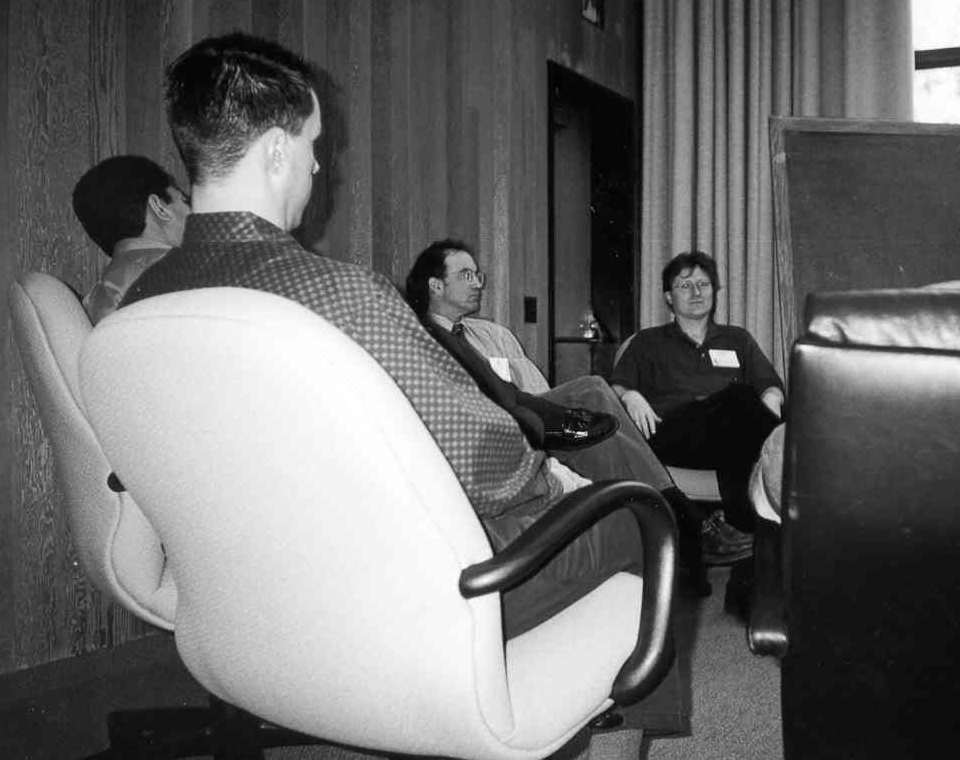
Department Chair, Sigurd Meldal, meeting with the Computer Science Department Industrial Advisory Board.
We have enjoyed a successful start of this academic year, with US News & World Report ranking the department first in the nation among primarily undergraduate computer science departments. One aspect of our success is the superior adaptability of our curriculum. While ensuring that all our graduates possess the core competencies of successful computer professionals, the department is continuously evaluating our strategic direction, modifying and improving our curriculum as needed.
I would like to draw your attention to two new areas of development: bioinformatics and software engineering. In the field of bioinformatics we see the synergy of two exploding research and development areas: computer science and molecular biology. The potential for improving the human condition arising out of this field is immense, and computer systems comprise a core, enabling technology for the mapping and analysis of genomic material.
Closer to the core of our profession, the department is creating a new major in Computer Software Engineering. Taking the best of Cal Poly’s `"learn-by-doing`" tradition and the excellence of the established Computer Science and Computer Engineering programs, we are creating a software-oriented engineering program that retains the solid foundations of the existing programs, adds more mathematics and engineering science, and tops it off with an introduction to the challenges and joys of technology team management. Students will engage in large-scale, client-oriented systems development for real customers. They will also make engineering tradeoffs while striving for that often elusive engineering goal of delivering a significant software product on time, on target and on budget. As we are enjoying a strengthening of support from industry and alumni, I invite you to join us in the exploration of these new directions, and in maintaining the high quality of our existing programs and offerings.
When Cisco’s Chairman of the Board John Morgridge came to Cal Poly to dedicate the Cisco Systems Advanced Network Laboratory, he paid tribute to the Cisco employees and Cal Poly staff who made it all possible.[^27] `"In the computer industry, it’s easy to make that (university) contact a check. But for partnerships, you need human involvement.`"
Cal Poly benefited from that human involvement as Cisco representatives and Cal Poly technology staff spent about six months planning the lab and another six months assembling it in the Engineering East Building. Much of the installation and setup of the facility was performed by Cal Poly alumni now working for Cisco. `"...for partnerships, you need human involvement.`" Barry Bruins (BS Csc 1983), a director of engineering at Cisco, is enthusiastic about alumni involvement in the project. ‘"By getting alumni involved with the networking curriculum, we were able to make major improvements in the students’ knowledge of the fundamentals of Internet technology,‘" Bruins said. ‘"These fundamentals will help them in whatever area of the Internet economy they find themselves.’’ The Cisco Advanced Network Laboratory replaced the old networks lab and has allowed the network offerings in the curriculum to expand. A new graduate computer networks course has joined the list alongside the two undergraduate network courses. Besides Computer Science and Computer Engineering students, the lab also serves the College of Business network courses.
The laboratory configuration offers enough equipment for 32 students to perform network experiments simultaneously, using switches, hubs, routers with Voice Over IP as well as ATM, fast ethernet, token ring, and ISDN capabilities. Cisco’s major support for the lab was enhanced by donations from Intel and NetCom, bringing the total cost of creating the lab to about $1 million. Bruins said Cisco looks forward to a continuing, long-lasting relationship between Cisco and Cal Poly; and is already seeing the benefits of the partnership. `"Seeing students excited about the technology and eager to apply their knowledge in the industry is a reward in itself.`"
There are currently about 300 Cal Poly graduates working for Cisco Systems.
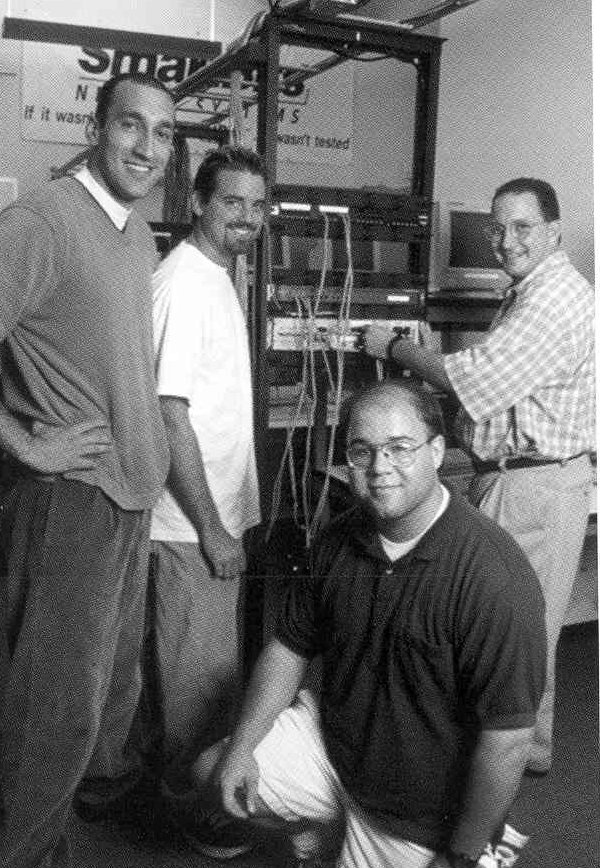
Professor Hugh Smith works with students in the Cisco Systems Advanced Networks Laboratory, which allows 32 students to perform experiments simultaneously. Left to right: Ali Torabi, Rob Collier, Terry Ott, and Dr. Hugh Smith.
US News & World Report of September 11, 2000, published their annual ranking of colleges, and this year they have also ranked departments. The Csc department is found under the Engineering Departments/Computer subcategory, and are ranked “number one” in the nation among the undergraduate (non-Ph.D. granting) institutions.[^28]
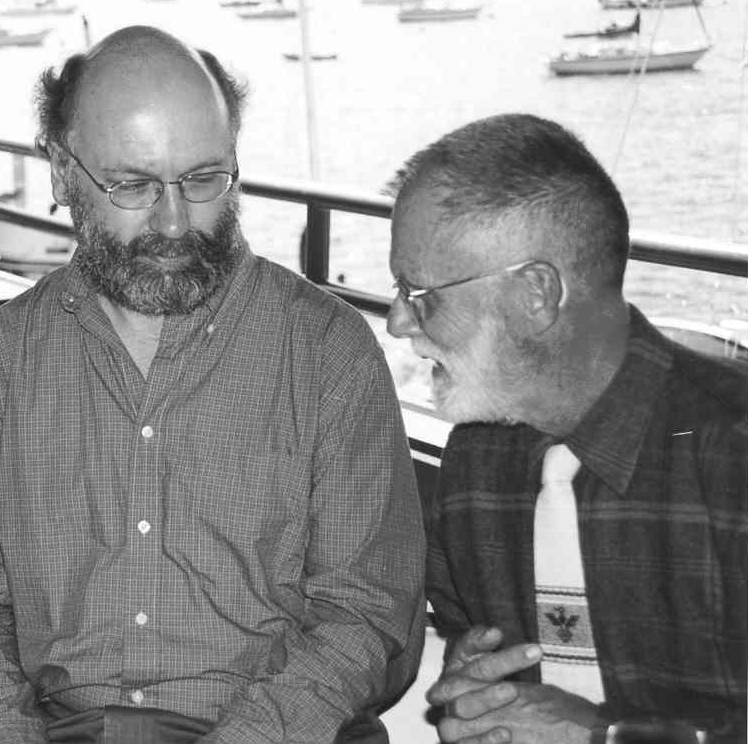
Franz Kurfess and Pat Wheatley discussing a computer science issue with backdrop of Morro Bay.
We quote here an email from Cal Poly University Vice President for Academic Affairs, Paul Zing.
From: [email protected]
Date: Fri, 1 Sep 2000 12:27:08 -0700
Subject: USN&WR Rankings
Congratulations to all of you for the rankings that CPE and Csc have achieved in this year’s US News & World Report sweepstakes. Although the meaning and value of these rankings can be argued endlessly (especially by those not highly ranked), achieving #1 is no mean feat under any circumstances. This recognition is a testimony to outstanding students, a dedicated faculty, and able leadership over the years.
Cal Poly is grateful for what you have achieved. What the public (and legislature and Chancellor’s Office) do not completely recognize very well, though, is the magnitude of this achievement in the absence of needed resources. While Cal Poly is #1 in academic reputation (a measure of a quality faculty) and selectivity (a measure of demand among high quality students), we are in the middle of the pack regarding resources. All the more impressive what you and your colleagues have achieved. Again, congratulations – for the firm foundations established and the clear challenges ahead.
Paul
Professor Clint Staley and Administrative Analyst Ellen Stier were chosen as recipients of the highest university honors for outstanding faculty and staff for the 1999-2000 year. Staley, legendary enough to have a student-run web site devoted to him, was named Distinguished Teacher. Stier, who was described as `"the glue that holds the department together,`" was named Outstanding Staff. Each award is given to only three employees each year.
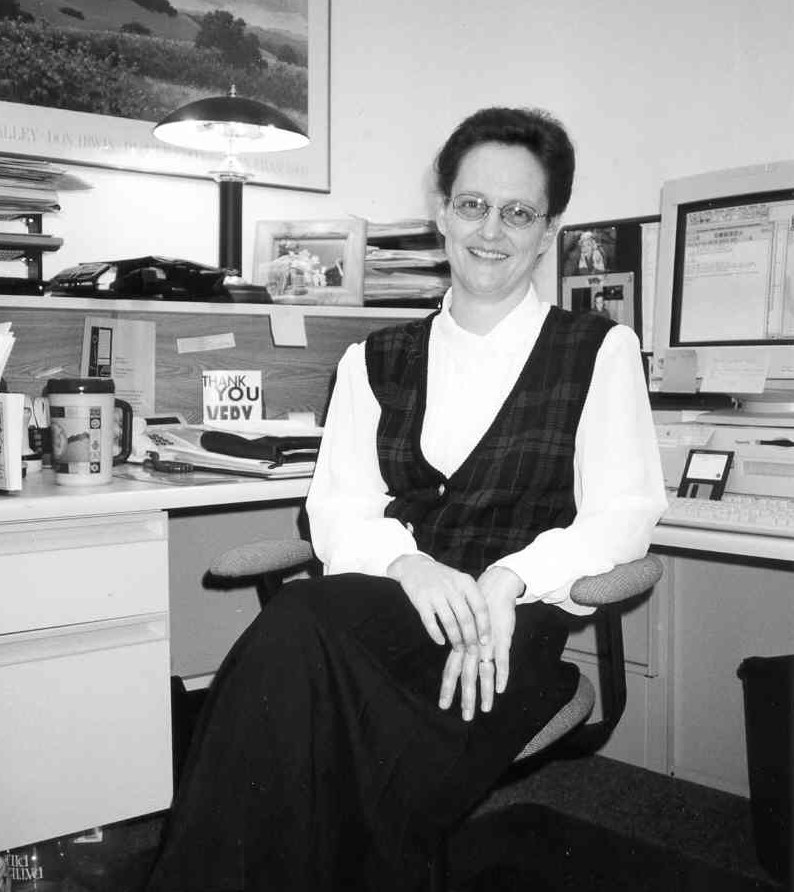
Ellen Stier, Cal Poly Outstanding Staff Award Winner, 1999-2000.
Staley has taught computer science at Cal Poly since 1988 and has earned numerous department and college teaching awards over the years. He is described as `"the toughest professor you’ll ever love,`" and was lauded for his ability to challenge students and bring real world experience to the classroom. Staley teaches the accelerated introduction to computer science, as well as object oriented GUI design courses. Stier was honored for her ``wisdom and counsel`" along with her job performance. According to the Computer Science Department chair, Sigurd Meldal, `"She stands out by really caring about the department and being aware of all the technical, professional and political issues that affect our work.`" Stier has been chair or member of many department, college and university committees and is respected across campus. She has been at Cal Poly since 1984.
Distinguished teachers are nominated by students and alumni of the university, and selected by a committee of past awardees. Outstanding staff are nominated by faculty, staff or students, and are also selected by a committee of past awardees. Staley and Stier were both honored at university-wide events during Fall 2000.

Office staff celebrating Ellen Stier’s Outstanding Staff award. Diane Goldman, Ellen Stier, Sigurd Meldal; Department Chairman, and Haley Landis.
To answer a growing need for practitioners who combine the best of software development and engineering discipline, the Computer Science Department has proposed a new Bachelor of Science Computer Software Engineering (BSCSE) degree. The program, if approved at all levels of the review process, could accept its first students as early as Fall 2003.[^29]
Back in the 1960s and ’70s most software development was about achieving efficient calculation. The focus in software research and practice was to create new programming languages and better algorithms: a mathematical endeavor.
The increasing complexity and scale of today’s software has moved the primary challenge of software construction from the details of efficient code generation more towards component-based system construction and the ability to make tradeoffs involving reliability, cost, time and even safety. In order to make such tradeoffs in a responsible manner, practical knowledge of engineering principles is a necessity. The field of Computer Software Engineering has traditionally addressed the problems associated with all aspects of the development of large-scale computer systems.
Trends in software development also underline the important need for an engineering oriented curriculum. Even simple programs involve many thousands of lines of code. As a result, students must learn by analyzing, modifying, and using existing software, rather than simply writing small programs on their own.
Tools necessary for modern Computer Software Engineering have similarly advanced. An editor and compiler are no more adequate for gaining a professional mastery of software construction than the use of a home chemistry set is for the teaching of industrial chemical or biological processes. A standard industrial software systems project may require thousands of dollars worth of development software, including databases, middle tier libraries, GUT libraries, source-code control systems, object-oriented design tools, and associated hardware such as dedicated servers, computer networks, and workstations.
Furthermore, one individual, no matter how capable, can no longer develop the complex software required to meet society’s demands. Most software design and construction involves a complex engineering process, and our students must learn to work effectively in teams in order to succeed in the current market for software practitioners.
The majority of the graduates from the Computer Engineering and Computer Science programs develop and/or maintain software applications. A large proportion of the jobs today are in computer software applications development, i.e., Computer Software Engineering. Cal Poly surveys each year’s graduates, achieving a representative sample of their professional direction. Of those surveyed, 40% were employed as Computer Software Engineering professionals, even though their degrees were in computer science or computer engineering.
In many respects, the establishment of a Bachelor of Science Computer Software Engineering degree constitutes an identification and labeling of an existing curricular path in a growing discipline. The Computer Science Department has offered a sequence of courses preparing students for a Computer Software Engineering profession for a number of years, and has recently added three new courses specifically addressing the students’ need for management experience, providing them with an emphasis on the engineering of computer software development. The Computer Software Engineering degree differs from the Computer Engineering and Computer Science degrees in significant ways:
-
The CSE classes place an emphasis on software processes and lifecycles.
-
The CSE classes include significant learning in engineering and management areas (software quality assurance, testing, software metrics, maintenance issues, configuration management, and personnel management).
The curriculum includes a year-long capstone sequence where the students work in teams to build a large software system. Students are required to complete a co-operative education experience prior to enrollment in the capstone courses.
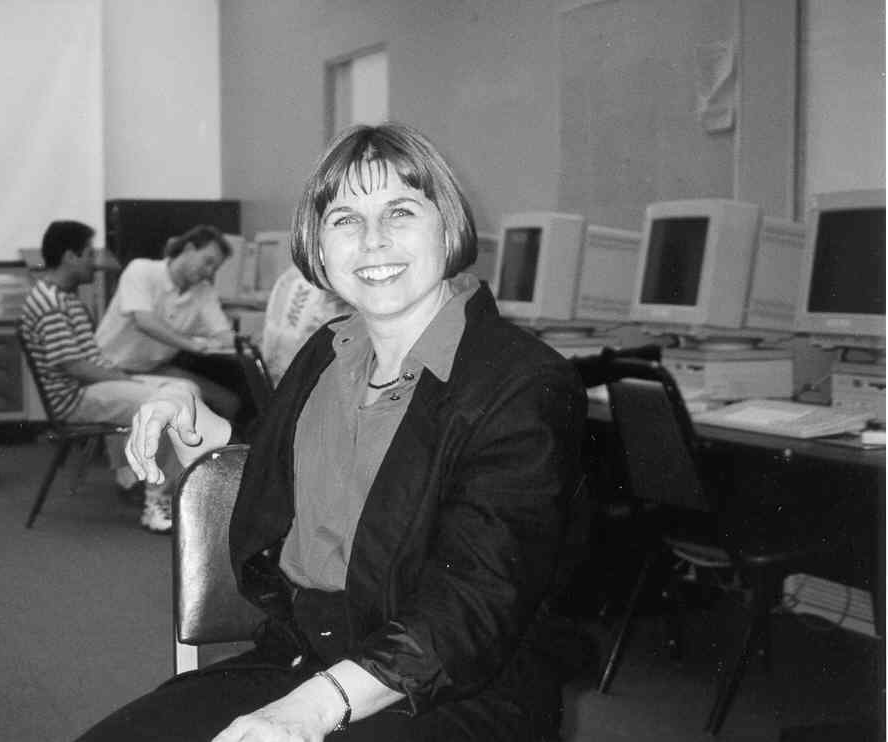
Erika Rogers working with students in her laboratory.
A unique feature of the capstone courses is their integration with lower division courses. The laboratory periods of the upper-division sequence are integrated with sections of the lower division sequence. The senior Computer Software Engineering students work in teams to build deployable software, and the teams will be made up of students from both the upper division and the lower division courses. Thus the upper division students will also serve as technical and administrative leaders for the lower division students on their teams.
Tim Kearns, whose research interests are database systems, data warehousing, and data mining, joined the faculty in 2001. He also works with the biology department to build stronger set of courses in bioinformatics and biotechnology. Tim earned his Ph.D. from University of Notre Dame. His career has included technical and management positions at AT&T’s Bell Labs, Hewlett-Packard and Price Waterhouse. He had a prior appointment at Cal Poly in the 1980’s.
Associate Professor Franz Kurfess was drawn to Cal Poly because teaching is taken seriously here. He has added depth to the department’s expertise in artificial intelligence, and specializes in knowledge organization management and neural networks for knowledge representation. Franz received his Ph.D. from Technical University in Munich, Germany. He came to Cal Poly from Concordia University in Montreal, Canada.
Associate Professor Hasmik Paulson’s interest are in numerical methods and computer science theory. She completed her Ph.D. in the former USSR, where she taught at Yerevan State University in the Republic of Armenia. She has continued her work on the numerical solutions of integral equations.
One reason Professor Hugh Smith enjoys Cal Poly is industry’s enthusiasm for the computer science and computer engineering programs. He helped shape the new network lab as it was being developed at Cal Poly and Cisco and now takes full advantage of the technology in his courses. Hugh earned his Ph.D. from Michigan State University. He is the advisor to the student chapter of ACM.
Clark Turner uses case studies to teach students in the “Professional Responsibilities” course that technical aspects are inseparable from social and ethical aspects of engineering. With a law degree from the University of Maine as well as a Ph.D. degree from UC Irvine, Turner was named Csc Professor of the year in his first year of teaching in 1999-2000. He is the advisor of the Linux User Group and is working with a team of engineering students and faculty to build and launch a satellite.
Former CPE director, Joe Grimes, now Special Assistant to the Provost for Faculty Development and Industrial Relations, continues to stay in touch with faculty and students by teaching part-time. Len Myers is now associate director of the CPE Program working with Director, EE Professor, Art MacCarley.
Long time faculty members, Elmo A. Keller, John Connely and Ray Boche have entered into the faculty early retirement program, which allows them to be involved with the Csc faculty and students while teaching part time.

Key faculty in the software engineering program. Left to right: Clint Staley, and Gene Fisher.